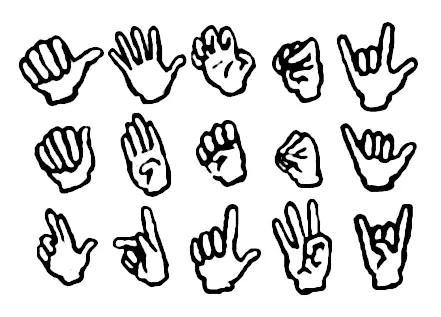Handshapes and gestures are the building blocks of sign languages, embodying diverse meanings and expressions across various linguistic systems. While there are commonalities in handshapes among different sign languages, each language possesses its own distinct set of established handshapes, contributing to the richness and uniqueness of each linguistic system.
Varieties of Handshapes Across Sign Languages
Sign languages globally incorporate an array of handshapes, each symbolizing specific concepts, objects, or actions. For instance, the “A” handshape, formed by extending the thumb and index finger while keeping the other fingers closed, is prevalent in American Sign Language (ASL) and signifies numbers or letters.
However, the same handshape might convey different meanings in other sign languages. In British Sign Language (BSL), this handshape represents the letter “T,” showcasing the variability in handshape meanings across languages.
Phonological and Semantic Significance
Handshapes play a crucial role in sign language phonology, akin to the role of phonemes in spoken languages. They are essential in distinguishing between signs and conveying nuances in meaning. Different handshapes, combined with movements and locations, create a wide range of signs with distinct semantic implications.
The “5” handshape, formed by extending all fingers, is a fundamental example found in many sign languages. In ASL, it represents the number “5,” while in other sign languages, it might symbolize various concepts, such as “book,” “car,” or “wait.”
Cultural and Regional Variances
Each sign language exhibits its unique set of handshapes, influenced by cultural and regional factors. For instance, Japanese Sign Language (JSL) incorporates specific handshapes and gestures that align with Japanese cultural norms and expressions, differing from those found in European or American sign languages.
Additionally, certain handshapes might carry cultural connotations or references. In some sign languages, gestures resembling local customs or symbols may be integrated into the lexicon, reflecting the cultural identity embedded within the language.
Importance of Handshape Recognition
Understanding the nuances of handshapes is crucial for effective communication and interpretation in sign languages. Interpreters and learners must grasp the intricacies of handshapes to accurately convey and comprehend signs.
Furthermore, recognizing the variations in handshapes across sign languages emphasizes the need for cultural and linguistic sensitivity. It underscores the importance of learning sign languages within their cultural contexts, acknowledging and respecting the diversity present in each linguistic system.
Conclusion: Embracing the Diversity of Sign Language Handshapes
The intricate world of sign language handshapes is a testament to the richness and diversity of human communication. While there are shared handshapes among sign languages, the unique combinations and meanings within each language highlight their individuality and cultural significance.
Appreciating and understanding the diverse handshapes in sign languages not only enhances communication but also fosters a deeper appreciation for the cultural and linguistic diversity present within these vibrant linguistic systems. Embracing the nuances of handshapes in sign languages contributes to a more inclusive and respectful global community.




One thought on “The Diversity of Handshapes and Gestures in Sign Languages”